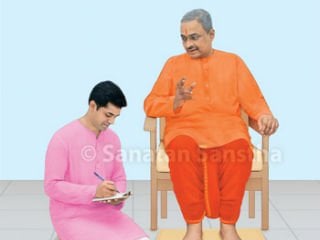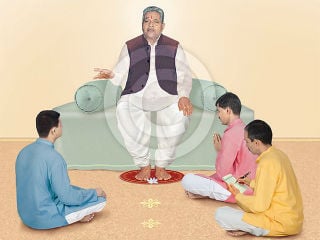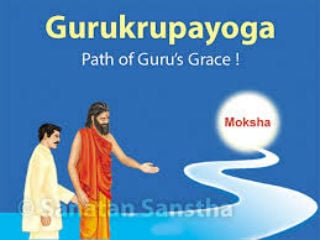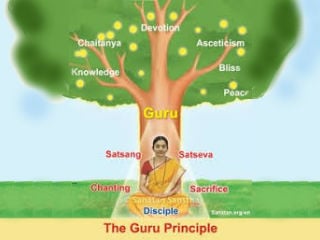This article explains various types of Gurus, their method of teaching and achieving spiritual progress of disciples.
1. Type as per the form and absence of a Guru
The table ahead illustrates the types of Gurus according to the form and an outline of their missions. This will clarify points such as the necessity of a Guru, who needs Guru, etc. In this regard, from the worldly perspective, the point to be considered is that till the thoughtless state (that is, a spiritual level of 70% is attained), spiritual evolution takes place faster if one has a Guru in human form. Thereafter, for further spiritual progress a disciple mostly receives guidance from within.
| Form of the Guru | |||||
|---|---|---|---|---|---|
| Physical form | Holy text | Idol | Others | Not having a Guru | |
| Deciding what to teach, as per the ability of the disciple | Possible | Not possible | Not possible | Not possible | – |
| Clarification of doubts | Possible Immediately | Possible to some extent after lot of reading | Not possible | Not possible | – |
| Time required to develop faith | Very little | Little | More | A lot | – |
| Motivation, teaching, exams | Possible | Not possible | Not possible | Not possible | – |
| Guidance to reduce destiny and accumulated account and elimination of negative energies that create obstacles in spiritual practice | Possible | Not possible | Not possible | Not possible | – |
| Benefits of Chaitanya (Divine consciousness) upon being in the company of the Guru | Possible | Not possible | Little | Not possible | – |
| Benefit of Guru’s grace | Possible | Not possible | Not possible | Not possible | – |
| Proportion of disciples leaving spiritual practice in between | Less | More | Very high | Very high | Very high |
| Time required for spiritual progress | Less | More | A lot | A lot | A lot |
| Personality of the disciple as per psychology which is suitable to the form of Guru | One who is in more need of guidance | Independent | One who needs support | Independent | Very independent |
| Normally, a disciple at what spiritual level can benefit ? | 55 | 40 | 60 | 30 | – |
| Efforts to be made by the disciple / seeker (%) | 60 | 70 | 70 | 70 | 100 |
| Qualities necessary in the disciple | Satseva and tyag | Understanding the implied meaning | Getting guidance from within | As per the type | High ego (faith in oneself) |
| Proportion of spiritual progress | 2-3 | 0.25 | 0.75 | 0.25 | 0.001 |
2. Guru, Sadguru and Paratpar Guru
2A. Definition, meaning, mission and role in the disciple’s progress
| Guru | Sadguru | Paratpar Guru | |
|---|---|---|---|
| 1. Definition and Meaning | A. One who provides Knowledge of Maya (The Great Illusion) and Guru Principle B. Dnyanguru C. Physical form |
A. One who provides atmanubhuti and makes one realise that there is Brahman everywhere B. Dikshaguru C. Name of God |
A. One who provides Spiritual experience of advait B. Muktiguru C. Advait |
| Spiritual level (%) | 70% | 80% | Over 90% |
| Spiritual experiences obtained by the self and others | Shakti (Divine Energy) | Anand (Bliss) | Shanti (Serenity) |
| Spiritual practice of the self | Yes | Yes | Not required |
| Attaining Moksha (Final Liberation) | Possible | Easily possible | Has already attained Moksha |
| Seat of the Kundalini A. In daily life B. At the time of performing spiritual practice |
Anahat-chakra Adnya-chakra |
Vishuddha-chakra Sahsrar-chakra |
Sahsrar-chakra – (Do not perform spiritual practice) |
| Behaving as per the rules of the sect to guide others | Yes | Yes | – (Have gone beyond the restrictions of the sect) |
| Eliminating negative energies A. Eliminating superior negative energies such as superior ghosts, black magic etc. B. Method used for eliminating superior Negative energies |
Possible, but difficult The act has to be performed with an intention |
Possible Resolve |
Easily possible Even a resolve is not required. Upon coming in their presence, the negative energies automatically leave |
| Subject on which they speak | Spirituality | Spirituality | Any subject |
| Method of performing miracles | Praying to God or the Guru | Resolve | As part of their duty, the supernatural powers and Deities perform miracles for them |
| Function A.B. |
Preparing the disciple for spiritual practice
Bestowing spiritual experience of sagun (Materialised) Chaitanya (Present in the Guru) on the disciple |
Sowing the seed of spiritual practice in the disciple
Bestowing spiritual experience of nirgun (Non-materialised) Principle |
Taking the disciple towards advait
Bestowing spiritual experience on the disciple, that sagun-nirgun are one and the same |
| At what spiritual level (%) does the disciple attain a Guru | 55 | 70 | 80 |
| Spiritual practice of the disciple | The Guru tells the disciple to perform spiritual practice in words | Without the knowledge of the disciple, the Guru gets spiritual practice done by a resolve | Spiritual practice of the disciple takes place automatically, by the mere presence of the Guru |
| Teaching (%) A. Through words B. Beyond words |
70 30 |
40 60 |
2 98 |
| Maximum spiritual progress of the disciple (%) | 70 | 80 | 100 |
| Role in the disciple’s progress (%) | 30 | 40 | 50 |
The vibrations of Ānand are 10 lakh times subtler than those of Shakti, and the spiritual experience of Shanti are infinite times subtler than the vibrations of Anand, that is, subtlest. Hence, when a seeker begins to understand the subtle, he first identifies the Guru at the level of Shakti, then Anand and lastly Shanti.
The points ahead elaborate on the difference between a Guru, a Sadguru and a Paratpar Guru.
Spiritual level of an ordinary individual, a disciple and the Guru, Sadguru and Paratpar Guru and the proportion of the three components in them : Sattvik (Sattva-predominant), rajasik (Raja-predominant) and tamasik (Tama-predominant) are words used in the context of an ordinary individual. Once the individual crosses the spiritual level of 50%, his attitude becomes introverted. Then, no importance is attached to the three components in his constitution. As provided in the table ahead, generally the proportion of the three components remains constant. Only quantitatively they decrease, that is, one progresses towards becoming trigunatīt or towards the Purushtattva.
| Spiritual level (%) | Proportion of the trigunas (%) | Total number of trigunas (%) | |||
|---|---|---|---|---|---|
| Sattva | Raja | Tama | |||
| Ordinary individual A. Tamasik B. Tamasik-rajasik C. Rajasik-sattvik D. Sattvik |
20 30 40 50 |
20 30 40 50 |
30 30 30 30 |
50 40 30 20 |
100 70 50 30 |
| Disciple | 60 | 50 | 30 | 20 | 20 |
| Guru | 70 | 50 | 30 | 20 | 10 |
| Sadguru | 85 | 50 | 30 | 20 | 1/10 |
| A. Sadeha B. Videha (Moksha = 100%) |
100 100 |
50 0 |
30 0 |
20 0 |
1/1000 0 |
2 B. Normal comparative proportion of various components
| Proportion (%) | |||
|---|---|---|---|
| Guru | Sadguru | Paratparguru | |
| 1. Unmanifest bhav (Spiritual emotion) | 70 | 80 | 90 |
| 2. Yearning | 70 | 80 | 90 |
| 3. Guidance | 50 | 70 | 90 |
| 4. Prīti (Unconditional love) | 30 | 50 | 80 |
| 5. Ego | 10 | 8 | 5 |
2 C. Mission and its nature
| Guru | Sadguru | Paratparguru | |
|---|---|---|---|
| 1. Oneness with the Guru Principle | For a few moments | For some time | Completely one |
| 2. Ego | 10% or more | Less than 10% | 2 to 0% |
| 3. Gross and subtle form of the mission | Mostly gross, but sometimes subtle | Through the gross in greater proportion and very little through the subtle | In greater proportion through the subtle and occasionally through the gross |
| 4. Extent of the mission | Limited to a certain area on the earth | Bhūlok (Earth region) to Swargalok (Heaven) | Saptalok |
| 5. Form of guidance | Regarding worship of God’s tarak (Saviour) form | Mainly regarding worship of God’s tarak form and mere explanation about God’s marak (Destroyer) form | Guiding about God’s tarak and marak form as per the times and getting spiritual practice done according to it. |
| 6. What do they impart to the seeker | Unique knowledge and inferior or spiritual experience related to Maya | Moderate or a little higher level spiritual experience and little knowledge | Complete knowledge and essential (Inferior, moderate and higher level) spiritual experience |
| 7. Period required for making the disciple obtain Moksha | Many births | Few births | Few years |
| 8. Performing the mission of reinstatement of Dharma (Righteousness) | No, out of many, hardly one Saint performs this task | Helping the mission of reinstatement of Dharma | Performing the mission of reinstatement of Dharma and in the process, getting spiritual practice performed from others. |
3 D. Proportion of Divine
characteristics and the tarak and marak form
| Guru | Sadguru | Paratparguru | |
|---|---|---|---|
| 1. Divine characteristics and their proportion (%) | |||
| 1A. Shakti Principle | 30 | 20 | 10 |
| 1B. Manifest Chaitanya Principle | 30 | 20 | 10 |
| 1C. Anand Principle | 10 | 20 | 10 |
| 1D. Shanti Principle | 10 | 10 | 30 |
| 1E. Unmanifest Chaitanya Principle | 10 | 10 | 10 |
| 1F. Guru Principle | 10 | 20 | 30 |
| Total | 100 | 100 | 100 |
| 2. Tarak form | |||
| 2A. Principle | More of sagun-nirgun | Very less sagun-nirgun | Nirgun-sagun |
| 2B. Components | Raja-Sattva | Sattva-Raja | Sattva |
| 2C. Manifest active waves | Ichha (Desire)-kriya | Kriya-dnyan (Knowledge) | Dnyan-kriya |
| 2D. Behaviour | Kind (Love for seekers) | Compassionate (Along with the seekers, taking care of happiness-unhappiness of their families too) | Grace bestowing (By bestowing grace, taking everyone beyond happiness-unhappiness) |
| 2E. What is the mission dependent on ? | On the manifest bhav of the individual | On the unmanifest bhav of the individual | Less ego |
| 2F. Mission | Brahmanda (Universe) | Brahmanda and in the void of Brahmanda | Mission beyond the Brahmanda |
| 3. Marak form | |||
| 3A. Principle | Sagun | When compared with tarak Principle, more of sagun and less of nirgun | Little more of sagun when compared with nirgun-tarak Principle |
| 3B. Components | Raja | Raja-Sattva | Sattva-Raja |
| 3C. Manifest active waves | Kriya-ichha | Kriya | Kriya-dnyan |
| 3D. Behaviour | Conserving Kshatravrutti | Creating Kshatratej for fighting (Having leadership) | |
| 3E. What does the mission depend upon | Manifest Kshatravrutti, annoyance | Unmanifest Kshatrabhav, aggressiveness (Gratitude) | Surrender |
| 3F. Help in obtaining what kind of Moksha for the disciple | Inferior Moksha | Moderate Moksha | Superior Moksha (Actual Moksha) |
| 3G. Function | Reducing personal problems for a limited period | Reducing the basic energy of negative energies at the personal level | Repulsing the attacks of Negative energies on the entire samashṭi (Society) |
| 3H. Proportion in today’s Gurus (%) | 3 | 10 | 5 |
The unmanifest Chaitanya includes the Principles of Shakti, Anand and Shanti; however, the manifest Chaitanya in the Guru functions in the form of Shakti, in the Sadguru in the form of Anand and in the Paratpar Guru in the form of Shanti.
Reference : Sanatan Sanstha’s Holy Text on ‘Importance of the Guru, types and Gurumantra’


 The one and only Guru-disciple tradition of the Sanatan Sanstha which has proven special in...
The one and only Guru-disciple tradition of the Sanatan Sanstha which has proven special in... Who is proclaimed a Saint as per Science of Spirituality ?
Who is proclaimed a Saint as per Science of Spirituality ? Faith & Guru
Faith & Guru Who is a real Guru ?
Who is a real Guru ? The Guru Principle
The Guru Principle Offering gratitude unto the Holy feet of the Guru is true Gurudakshina !
Offering gratitude unto the Holy feet of the Guru is true Gurudakshina !